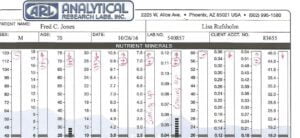Correcting your Sodium to Potassium ratio is a big part of the answer!
The Na/K is referred to as our energy ratio and THE most important ratio on a Hair Mineral Analysis test. These two very important electrolytes control so many functions! The balance between Sodium and Potassium is vital to your energy. Exhaustion is the deepest level of sodium to potassium tired, it can be debilitating.
The second most important ratio is your other two main electrolytes Calcium to Magnesium ratio indicates blood sugar measured from within the cell, but let’s focus primarily on Sodium to Potassium.
To be in optimal health for most functions, the ratio should be at 2.50 on the Hair Analysis with the other mineral levels such as Calcium, Magnesium, Zinc, Chromium, Selenium, etc. should be near normal levels.
What does it mean if the Na/K ratio is low?
When the ratio is even slightly below 2.50 you may start to develop health problems. We may call it a Sodium to Potassium inversion where the Sodium is visually lower than the Potassium level. This is considered the most severe imbalance our body can suffer from as it affects us from the cell out.
The inversion shows the entrance to a state of chronic physical exhaustion. Over time the body can develop severe physiological disruption and overall exhaustion due to the discharge of vital stores of energy as the Na/K ratio drops. As you encounter stress from life circumstances, lifestyle choices, detoxification of heavy metal toxicity, or even indecision, your Na/K ratio will lower negatively.
When one is in an inversion they may not realize they are sick and at times suffering emotionally. They may even be in a state of denial about their true health. Heavy metal toxicity of metals such as Copper, Iron, and Zinc can be extremely high or low reflective of energy issues and mask their true Sodium/Potassium balance.
If this life energy or vitality ratio drops under 2.1, you will only be creating low energy. At 1.8 or below energy levels are severely low. A ratio of 1.3 or less will tend to drive one’s ability to commit fully to relationships, careers, or plans due to inhibitions linked to their low Na/K.
Along with the Calcium/Magnesium ratio, this ratio dictates your state of health or the quality of health you are living. Together they affect sugar conditions such as hypoglycemia or blood sugar, trigger severe depression, anxiety, extreme mood swings, severe depression, and low energy. As we need to rebuild and re-balance all four electrolytes, it can be a challenge but it is what gives us the ability to achieve the best possible health.
What if your Sodium/Potassium ratio is high?
This not only can affect your physical body but will run over into your emotional self. I look at the trends or patterns associated with ratios and mineral levels. If a client has a Na/K ratio above 6 for a long time they are more likely to focus on the future than the present. They are also more emotionally aggressive. Let’s look at how the sodium to potassium tired feelings and behaviors are created.
Potassium reflects glucocorticoid levels (regulates glucose metabolism) and is linked to corticosteroid which balances your body temperature, stress responses, the balance of water in or around your cells, regulate energy flow with fat or glucose usage, and controls blood pressure from within the kidney by monitoring sodium retention and potassium excretion.
The corticoids help to reduce inflammation when needed for muscles or rashes, etc. as well as control stress and immune responses. If the cortisol is high you may have issues with weight gain (particularly around the midsection), anxiety, or insomnia. Saliva testing is only looking at the level at the time of the sample whereas Hair Analysis is a month-long snapshot at your average levels in a more accurate assessment.
Sodium reflects mineralocorticoid levels (regulates salt and water balance). Aldosterone is a pro-inflammatory Mineralocorticoid responsible for nourishing, protecting, and can alert the body to adjust your Sodium by raising them or lowering Potassium by releasing them from the cells in the kidneys for water regulation.
These corticoids stimulate Sodium re-absorption and are responsible for signaling to the body that inflammation is needed by releasing Aldosterone. This is a healing mechanism so that the body can deliver corticosteroid or cortisone as an anti-inflammatory response.
Mineralocorticoids can be disrupted by the heavy metal Arsenic which will interfere with your glucose hormone receptors. It also inhibits gene transcriptions (on or off) linking it to cancer.
How can the Sodium to Potassium ratio measure your energy levels?
As you can see, your Sodium, Potassium, and the ratio between the two is incredibly important for ALL functions in the body. It is your sodium to potassium tired ratio measurement. I will often use the analogy of your Na/K level showing the number of cars or transportation your body has available. They have to carry out all of the functions and minerals to where they need to be. If you have tired cells, you will have slow traffic jams with nothing getting to where it needs to be.
This chart is a guide to evaluating energy levels according to Dr. Paul Eck, the founder of the Hair Mineral Analysis I use at Analytical Research Labs, Inc. on a Hair Analysis:
Sodium (Na) to Potassium (K) Ratio =
20+ Serious physical and emotional disorders.
15-20 Low levels of energy (poor health).
6-15 Moderate to low levels of energy.
2.6-6 Moderate levels of energy.
2.5 Normal
2.4-2.2 Moderate levels of energy.
2.2-1.9 Moderate to low levels of energy (declining state of health).
1.9-1.5 Low levels of energy (poor health).
1.2 or lower Serious physical and emotional disorders.
When I see energy ratios too high at 6 or greater for a long period of testing, the person will be preoccupied with the future instead of living in the present. If far below the 2.5 range at 1.3 or less, the person’s mind is focused on the past. Either end of the range will make it more difficult for one to commit to other people or even careers.
How are your emotions linked to your Na/K ratio?
Our fears are primarily controlled by noradrenaline and adrenaline produced in the adrenal glands. Balancing the two keeps us stable emotionally and physically. The noradrenaline in excess can push one to behave offensively with aggression thus preventing the expressions such as compassion or affection.
Contrarily, adrenaline can trigger excessive defensiveness. One would feel fearful and inhibited from expressing their true self or feel the joy of letting go of fears. Potassium represents adrenaline and Sodium represents the noradrenaline balance.
If one is not balanced in their Sodium and Potassium (tired) ratio it can trigger an emotional behavioral change. A low level of Sodium reflects aggressiveness or a lack of assertiveness. Fearfulness is connected to a higher level of Potassium.
Someone with a low Na/K is fearful often and unable to express their emotions so they are inhibited. They don’t know how to show their loving or kind thoughts, unable to let their feeling out. At times the low ratio may not appear until the second or third retest as the chemistry is balancing. The personality factor is there along with the hair analysis pattern.
Having a consultant such as myself with over a decade of experience in reading Hair Analysis is very important to show you how to navigate your true chemistry.
Your sodium to potassium tired cells are asking for your attention and help. If you are ready to increase your energy from the cellular level for true, natural power.
LET’S CHAT about your health goals!
Copyright Scientific Nutrition, LLC 2021
To read more about the importance of a balanced Sodium to Potassium level go Na/K .




